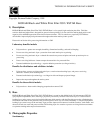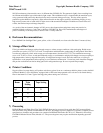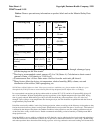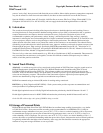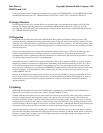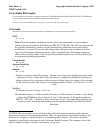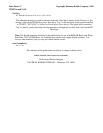Data Sheet—4 Copyright, Eastman Kodak Company, 1999
TI2497 Issued 11-99
prone to "static cling" when processed with Staticide process additive. Other similar quaternary ammonium compounds
may also be effective as final rinse anti-static additives, but have not been certified for use in the D97 Process.
Staticide 3000G is available from ACL Staticide, 1960 East Devon Avenue, Elk Grove Village, Illinois 60007, USA
(Telephone: 847-981-9212, Fax: 847-981-9278), who can supply the chemical through distributors worldwide.
8) Lubrication
The scratch-resistant polymeric backing offers improved resistance to backside abrasions and scratching. Process-
surviving lubricants are incorporated into both the backing and the top layer (SOC) of the emulsion side, to optimize
transport characteristics and improve abrasion resistance. However, post-process lubrication of prints is still
recommended to optimize print performance, reduce "dusting", and extend print life. Edge-waxing is especially
important for reducing the wear and extending the life of digital soundtrack information printed on 35 mm film in areas
of severe projector abrasion, such as along the edges or between the perforations. The additional lubrication helps
reduce abrasion of the film, much as wax protects the surface of fine furniture or an automobile. The reduced friction
afforded by proper lubrication also reduces perforation wear, improves steadiness, and results in quieter transport of the
film through the projector. Edge waxing is specified by SMPTE Recommended Practice RP 151, "Lubrication of 35
mm Motion-Picture Prints for Projection" and specified in KODAK Publication No. H24-02, "Manual for Processing
EASTMAN Color Films, Module 2, Equipment and Procedures".
The use of oils, or other non-volatile materials (e.g., WD-40) as film lubricants is NOT recommended. These materials
may cause the film convolutions to stick together, or make rolls difficult to handle. Oil deposits may be visible as
mottle, or hold dirt particles on the film.
9) Sound Track Printing
ANALOG—A variable -area positive silver sound track can be printed on 2302 Film from a negative sound record on
KODAK Panchromatic Sound Recording Film 2374, KODAK Panchromatic Sound Recording Film 2376 and
EASTMAN EXR Sound Recording Film 2378. The optimum variable-area sound track density for the print lies
between 1.0 and 1.8 measured visually. This print density is chosen to provide a good compromise between signal to
noise ratio and frequency response. The densities of the sound-track negatives required to produce optimal print
densities are determined by using recognized cross-modulation test procedures.
KODAK recommends using an infrared (IR) reader for reading analog sound track.
DIGITAL (e.g. Dolby Digital and SONY SDDS)—Each system vendor provides exposure recommendations and
control procedures for optimum performance.
Kodak digital optimization tests for Dolby Digital indicate that the print density should fall between 1.0 and 1.7.
Kodak digital optimization tests for SONY SDDS indicate that the print density should fall between 0.5 and 2.0.
Order SO-302 without edge code (print) if SDDS is being recorded.
10) Storage of Processed Prints
KODAK Black-and-White Print Film 2302 / ESTAR Base has excellent image stability characteristics, very similar
to 5302/ SO-434 Film. Store processed film according to the recommendations in ANSI/PIMA IT9.11-1998: for
medium-term storage (minimum of ten years), store at 25°C (77°F) or lower at a relative humidity of 20 to 50 percent;
for extended-term storage (for preservation of material having permanent value), store at 21°C (70°F) or lower at a
relative humidity of 20 to 30 percent. For active use, store at 25°C (77°F) or lower, at a relative humidity of 50 +/- 5
percent; this relates to optimized film handling rather than preservation. Static, dust-attraction and curl-related problems
are generally minimized at the higher relative humidity. After usage, the film should be returned to the appropriate
medium- or long-term storage conditions as soon as possible.



